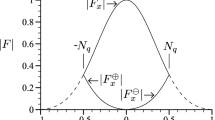Abstract
Two iterative PIV image processing methods are introduced, which utilize displacement and deformation of the interrogation areas to maximize the correlation. The velocity gradients used for the window deformation are iteratively estimated directly from the images and no velocity values are required from neighbouring interrogation areas, as with numerical differentiation. The improved accuracy and resolution of the velocity gradient estimation compared to numerical differentiation is shown using synthetic images. The performance in a real application is shown using experimental reference images.









Similar content being viewed by others
References
Hart DP (2002) PIV processing using multidimensional correlation. In: Proceedings of the 10th international symposium on flow visualization, Kyoto, Japan, Paper F0374
Huang HT, Fiedler HE, Wang JJ (1993) Limitation and improvement of PIV; part II: particle image distortion, a novel technique. Exp Fluids 15:263–273
Jambunathan K, Ju XY, Dobbins BN, Ashforth-Frost S (1995) An improved cross correlation technique for particle image velocimetry. Meas Sci Technol 6:507–514
Kähler CJ (2000) Multiplane stereo PIV—recording and evaluation methods. In: Proceedings of Euromech 411. Rouen, France
Lecordier B (1997) Etude de l’interaction de la propagation d’une flamme premelangee avec le champ aerodynamique, par association de la tomographie laser et de la velocimetrie par Images de particules. PhD Thesis, l’Universite de Rouen, France
Lecordier B, Lecordier JC, Trinité M (1999) Iterative sub-pixel algorithm for the cross-correlation PIV measurements. In: Proceedings of 3rd international workshop on PIV. University of California, Santa Barbara, USA
Lindken R, Poelma C, Westerweel J (2003) Compensation for spatial effects for non-uniform seeding in PIV interrogation by signal relocation. In: Proceedings of the 5th international symposium on particle image velocimetry. Busan, Korea, Paper 3302
Mayer S (2002) A generalized processing technique in digital particle image velocimetry with direct estimation of velocity gradients. Exp Fluids 33:443–457
Nobach H (2004) Accuracy of sub-pixel interpolation in PIV and PTV image processing. Technical report no. 001/2004, Technische Universität Darmstadt, Fachbereich Maschinenbau, Fachgebiet Strömungslehre und Aerodynamik
Nobach H, Honkanen M (2005) Two-dimensional Gaussian regression for sub-pixel displacement estimation in particle image velocimetry and particle position estimation in particle tracking velocimetry. Exp Fluids 38(4):511–515
Nobach H, Damaschke N, Tropea C (2004) High-precision sub-pixel interpolation in PIV/PTV image processing. In: Proceedings of the 12th international symposium on applications of laser techniques to fluid mechanics. Lisbon, Portugal, Paper 24.1
Nogueira J, Lecuona A, Rodriguez PA (1999) Local field correction PIV: on the increase of accuracy of digital PIV systems. Exp Fluids 27:107–116
Nogueira J, Lecuona A, Rodriguez PA (2001) Identification of a new source of peak locking, analysis and its removal in conventional and super-resolution PIV techniques. Exp Fluids 30:309–316
Ronneberger O, Raffel M, Kompenhans J (1998) Advanced evaluation algorithms for standard and dual plane particle image velocimetry. In: Proceedings of the 9th international symposium on applications of laser techniques to fluid mechanics. Lisbon, Portugal, Paper 10.1
Scarano F (2002) Iterative image deformation methods in PIV. Meas Sci Technol 13:R1–R19
Scarano F (2004) A super-resolution particle image velocimetry interrogation approach by means of velocity second derivatives correlation. Meas Sci Technol 15:475–486
Scarano F, Riethmuller ML (2000) Advances in iterative multigrid PIV image processing. Exp Fluids 29:S51–S60
Stanislas M, Okamoto K, Kähler C (2003) Main results of the first international PIV challenge. Meas Sci Technol 14(10):R63–R89
Tokumaru OT, Dimotakis PE (1995) Image correlation velocimetry. Exp Fluids 19:1–15
Willert CE (2000) Evaluation of digital PIV recordings. In: Application of particle image velocimetry—theory and practice, course notes, 6–10 March 2000, DLR Göttingen, Germany
Young CN, Johnson DA, Weckman EJ (2004) A method to anchor displacement vectors to reduce uncertainty and improve particle image velocimetry results. Meas Sci Technol 15:9–20
Acknowledgements
Funding from the Deutsche Forschungsgemeinschaft under grant Tr 194/21 is gratefully acknowledged.
Author information
Authors and Affiliations
Corresponding author
Rights and permissions
About this article
Cite this article
Nobach, H., Tropea, C. Improvements to PIV image analysis by recognizing the velocity gradients. Exp Fluids 39, 614–622 (2005). https://doi.org/10.1007/s00348-005-1001-9
Received:
Revised:
Accepted:
Published:
Issue Date:
DOI: https://doi.org/10.1007/s00348-005-1001-9




